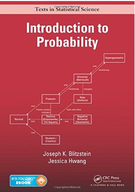Laplaces law of succession says that if X1, X2,...,Xn+1 are conditionally independent
Chapter 9, Problem 50(choose chapter or problem)
Laplaces law of succession says that if X1, X2,...,Xn+1 are conditionally independent Bern(p) r.v.s given p, but p is given a Unif(0, 1) prior to reflect ignorance about its value, then P(Xn+1 = 1|X1 + + Xn = k) = k + 1 n + 2 . As an example, Laplace discussed the problem of predicting whether the sun will rise tomorrow, given that the sun did rise every time for all n days of recorded history; the above formula then gives (n + 1)/(n + 2) as the probability of the sun rising tomorrow (of course, assuming independent trials with p unchanging over time may be a very unreasonable model for the sunrise problem). (a) Find the posterior distribution of p given X1 = x1, X2 = x2,...,Xn = xn, and show that it only depends on the sum of the xj (so we only need the one-dimensional quantity x1 + x2 + + xn to obtain the posterior distribution, rather than needing all n data points). (b) Prove Laplaces law of succession, using a form of LOTP to find P(Xn+1 = 1|X1 + +Xn = k) by conditioning on p. (The next exercise, which is closely related, involves an equivalent Adams law proof.)
Unfortunately, we don't have that question answered yet. But you can get it answered in just 5 hours by Logging in or Becoming a subscriber.
Becoming a subscriber
Or look for another answer
